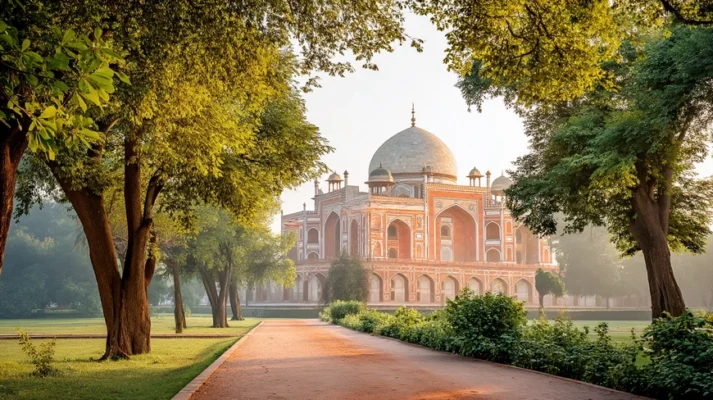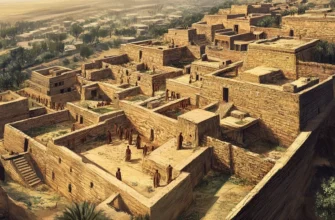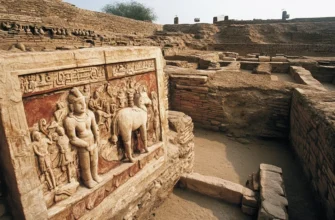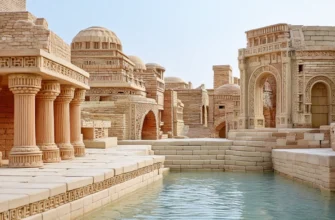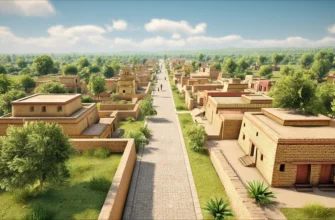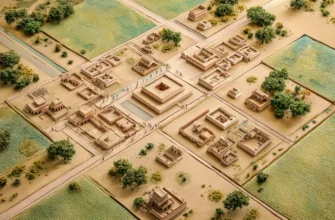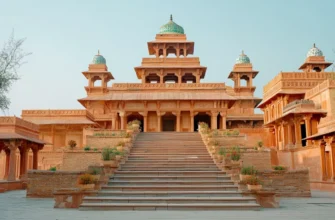Humayun’s Tomb, located in Delhi, is one of India’s most important architectural monuments and the first large mausoleum of the Mughal Empire. Its construction began in 1565, nine years after the death of Emperor Humayun, and was completed during the reign of his son, Akbar the Great.
The architectural style of the tomb is a wonderful combination of Islamic, Persian, and Indian elements. The large dome, decorated with mosaics and intricate details, blends harmoniously with the garden, creating an atmosphere of peace and grandeur. A distinctive feature is the use of red sandstone, which gives the building a unique appearance.
Humayun’s Tomb also served as an architectural prototype for the construction of the Taj Mahal, which later became a symbol of the Mughal Empire. The tomb’s inclusion in the UNESCO World Heritage List underscores its cultural and historical significance.
Today, this monument is an important tourist attraction and a popular place to learn about the history and culture of the Mughal Empire.
History of Humayun’s Tomb
Humayun’s Tomb is one of India’s most famous architectural monuments, located in Delhi, and is the first significant tomb of the Mughal Empire.
It was built in honor of Emperor Humayun, who died in 1556. His son, Emperor Akbar the Great, began construction of the tomb in 1565, but this grand project was only completed in 1572, during the reign of Akbar’s son, Jahangir.
The construction of the tomb was initiated by Humayun’s wife, Empress Hamida Banu Begum, who wanted to create a magnificent memorial for her husband.
The tomb was designed by Persian architect Mirza Ghias, who was one of the chief architects at the court of Emperor Akbar.
He ensured that Persian architectural traditions were combined with Indian and Islamic elements, making the tomb not only an important cultural site but also the first example of this mixed style in Mughal architecture.
The construction of the tomb took seven years and was completed in 1572, during the reign of Akbar’s son, Emperor Jahangir. Although the main work was completed at that time, individual elements of the building continued to be refined for several years after that.
The tomb became the first significant monument in a style that combines Persian, Indian, and Islamic art. It became a prototype for subsequent Mughal tombs, including the famous Taj Mahal.
The significance of the tomb is not limited to its architecture—it is also a symbol of the greatness of the Mughal Empire and a memorial to the great ruler Humayun, whose legacy has left a deep mark on the history of India.
Since 1993, Humayun’s Tomb has been listed as a UNESCO World Heritage Site, further confirming its cultural and historical significance to humanity.
Architecture of Humayun’s Tomb
Humayun’s Tomb is one of India’s most famous architectural monuments, and its architecture is a striking example of the fusion of Persian, Indian, and Islamic styles. It is the first large mausoleum of the Mughal Empire and served as a model for future tombs, including the famous Taj Mahal.
Main architectural elements:
Dome: The large dome, which is the central part of the tomb, has a diameter of about 15 meters and a height of 17 meters. The dome is a classic element of Islamic architecture and symbolizes the heavenly kingdom. It is made of white marble, which contrasts with the main red sandstone.
Red sandstone: The main material used in the construction of the mausoleum is red sandstone, which was used for the exterior walls. This gives the building a majestic and monumental appearance. Sandstone was also used in decorative elements, adding warmth and elegance to the structure.
Persian “four-part garden” style garden: The tomb is surrounded by a large garden divided into four parts, symbolizing the four rivers of Paradise according to Islamic belief. This is also a traditional element of Persian garden architecture. The garden is symmetrically designed, with water channels, pools, and beautiful alleys.
Interior of the tomb: Inside the tomb is the tomb of Humayun, which has a huge luxurious grave. The architectural style of the interior is also notable for its combination of Persian and Indian motifs. There are beautiful decorative elements — carved stones, marble panels, and mosaics.
Arches and minarets: Arches, typical of Islamic architecture, as well as four minarets at the corners of the building, add height and grandeur to the structure. The minarets serve not only a decorative but also a functional role, contributing to the harmony of the overall design of the tomb.
Thematic elements: The architecture of Humayun’s tomb also features numerous elements reflecting Islamic symbols, such as geometric figures, calligraphy, and quotations from the Quran, which adorn the walls and interiors.
Humayun’s Tomb became not only the first significant structure of the Mughal Empire, but also an example for subsequent mausoleums, notably the Taj Mahal, which used similar architectural motifs such as a central dome, a symmetrical garden, and the use of marble.
Humayun’s Tomb is an impressive example of the architectural genius of the time and an important stage in the development of Mughal architecture, reflecting the cultural fusion of different traditions.
Significance of Humayun’s Tomb
Humayun’s Tomb in Delhi is not only an architectural landmark but also a symbol of cultural, historical, and religious significance for India and the entire world. It has several important aspects that highlight its significance:
Humayun’s Tomb is the first large mausoleum of the Mughal Empire, which became the basis for the construction of numerous other tomb structures, including the famous Taj Mahal. It reflects the grandeur of the empire and its cultural richness, where architecture combines Islamic, Persian, and Indian elements. The tomb is an important symbol of the legacy of Mughal rule, which laid the foundation for the development of Indian culture in the centuries that followed.
The construction of Humayun’s Tomb was an important step in the development of Mughal architecture, as it was the first significant tomb to combine Persian garden architecture with Indian traditions. The style of this tomb became a prototype for subsequent architectural projects, including one of India’s most famous landmarks, the Taj Mahal.
Humayun’s Tomb is not only the burial place of the emperor, but also has a deep religious and symbolic meaning. Its layout in the form of a garden with four parts and water channels symbolizes the Islamic idea of Paradise. The symmetry and harmony of the space convey the idea of universal balance and divine beauty, which is important in Muslim culture.
In 1993, Humayun’s Tomb was added to the UNESCO World Heritage List, confirming its importance not only for India but for the whole world. This recognition highlights the importance of preserving and protecting cultural monuments that are part of our global heritage.
Today, Humayun’s Tomb is a popular tourist attraction, drawing thousands of visitors from around the world. It is an important place for studying history, culture, and architecture, as well as for those who wish to learn about the richness of Indian heritage.
Thus, the significance of Humayun’s Tomb goes beyond its architectural value. It is a cultural, historical, and religious symbol that continues to influence the development of India and the world’s heritage.
Conclusion
Humayun’s Tomb is one of India’s greatest architectural and cultural heritage sites, playing an important role in understanding the history, art, and religion of the Mughal Empire. It is not only the burial place of the great emperor Humayun, but also symbolizes the grandeur of the empire and its architectural achievements.
The tomb was the first important monument of the Mughal style, combining Islamic, Persian, and Indian architectural traditions, which became the basis for the further development of Mughal architecture, in particular for the famous Taj Mahal. Its thoughtful symmetry, use of red sandstone and white marble, and unique Persian garden architecture make the tomb a unique example of cultural fusion.
In addition to its architectural importance, the tomb has great historical and religious significance. It reflects the Muslim understanding of paradise through its garden landscape, clearly symbolizing the four rivers of paradise, and is an important place for understanding the history of the Mughal Empire.
Today, as part of UNESCO’s World Heritage, Humayun’s Tomb is not only a place to study history and architecture, but also an important tourist attraction that draws attention to India’s rich cultural heritage. It is a monument that preserves the memory of the greatness of Emperor Humayun and provides an opportunity to learn about important aspects.
